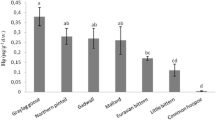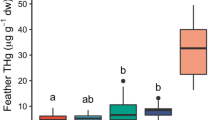Abstract
Mercury levels were determined in feathers from 83 birds belonging to 18 species (eight families), all collected from the northern region of Iran. Mercury levels were evaluated in relation to taxonomic affiliation and feeding strategies. Mercury levels in the feathers were between 0.05 ± 0.01 and 1.10 ± 0.15 μg g−1 dry weight, and there was a significant effect of taxonomic groups (p < 0.05). The highest mercury levels were found in Accipitridae, and mercury was not detected in the family Upupidae. The pattern for mercury levels was Accipitridae > Pelecanidae > Sternidae > Ardeidae > Anatidae > Rallidae > Phasianidae (p < 0.05). Significant differences (p < 0.05) in the mean mercury levels were found among species as a function of feeding method and trophic level. Mercury levels were highest in the carnivorous species and lowest in the herbivorous species. Mercury levels in feathers of birds in this study were generally below the thresholds reported to affect reproduction.


Similar content being viewed by others
References
Ambrose, R. E., Matz, A., Swem, T., & Bente, P. (2000). Environmental contaminants in American and arctic peregrine falcon eggs in Alaska, 1979--95. Ecological Services Fairbanks, AK, U.S. Fish and Wildlife Service, Technical Report NAES-TR-00-02. 67 pp.
Becker, P. H., Gonzalez-Solis, J., Behrends, B., & Croxall, J. (2002). Feather mercury levels in seabirds at South Georgia: influence of trophic position, sex and age. Marine Ecology Progress Series, 243, 261–269.
Behrooz, R. D., Esmaili-Sari, A., Ghasempouri, S. M., Bahramifar, N., & Covaci, A. (2009). Organochlorine pesticide and polychlorinated biphenyl residues in feathers of birds from different trophic levels of south-west Iran. Environment International, 35, 285–290.
Braune, B. M., & Gaskin, D. E. (1987). Mercury levels in Bonaparte’s gulls (Larusphiladelphia) during autumn molt in the Quoddy region, New Brunswick, Canada. Archives of Environmental Contamination and Toxicology, 16, 539–549.
Burger, J. (1993). Metals in avian feathers: bioindicator of environmental pollution. Reviews in Environmental Toxicology, 5, 203–311.
Burger, J. (1996). Heavy metal and selenium levels in feathers of franklin’s gulls in interior North America. Auk, 113, 399–407.
Burger, J. (2002). Food chain differences affect heavy metals in bird eggs in Barnegat Bay, New Jersey. Environmental Research Section A, 90, 33–39.
Burger, J., & Gochfeld, M. (1997). Risk, mercury levels, and birds: relating adverse laboratory effects to field biomonitoring. Environmental Research, 75, 160–172.
Burger, J., & Gochfeld, M. (2000a). Metal levels in feathers of 12 species of seabirds from Midway Atoll in the northern Pacific Ocean. Science of the Total Environment, 257, 37–52.
Burger, J., & Gochfeld, M. (2000b). Metals in albatross feathers from Midway Atoll: influence of species, age, and nest location. Environmental Research, 82, 207–221.
Cifuentes, J. M., Becker, P. H., Sommer, U., Pacheco, P., & Schlatter, R. (2003). Seabird eggs as bioindicators of chemical contamination in Chile. Environmental Pollution, 126, 123–137.
Connell, D. W., Wong, B. S. F., Lam, P. K. S., Poon, K. F., Lam, M. H. W., Wu, R. S. S., Richardson, B. J., & Yen, Y. F. (2002). Risk to breeding success of Ardeids by contaminants in Hong Kong: evidence from trace metals in feathers. Ecotoxicology, 11, 49--59.
Dauwe, T., Bervoets, L., Blust, R., Pinxten, R., & Eens, M. (2000). Can excrement and feathers of nestling songbirds be used as biomonitors for heavy metal pollution? Archives of Environmental Contamination and Toxicology, 39, 541–546.
Dauwe, T., Bervoets, L., Pinxten, R., Blust, R., & Eens, M. (2003). Variation of heavy metals within and among feathers of birds of prey: effects of molt and external contamination. Environmental Pollution, 124, 429–436.
Dauwe, T., Janssens, E., Bervoets, L., Blust, R., & Eens, M. (2005). Heavy-metal concentrations in female laying great tits (Parus major) and their clutches. Archives of Environmental Contamination and Toxicology, 49, 249–256.
Eisler, R. (1987). Mercury hazards to fish, wildlife, and invertebrates: a synoptic review. US Fisheries and Wild Life Service, Biological Report, 1, p. 85.
Gochfeld, M. (1997). Spatial patterns in a bioindicator: heavy metal and selenium concentration in eggs of Herring Gulls (Larus argentatus) in the New York Bight. Archives of Environmental Contamination and Toxicology, 33, 63–70.
Goutner, V., & Furness, R. W. (1998). Feathers of white stork (Ciconia ciconia) chicks in north-eastern Greece, as indicators of geographical variation in mercury contamination. Toxicology of Environmental and Chemistry, 67, 379–390.
Goutner, V., Furness, R. W., & Papakonstantinou, K. (2000). Mercury in feathers of Audouin’s Gull (Larus audouinii) chicks from northeastern Mediterranean colonies. Archives of Environmental Contamination and Toxicology, 39, 200–204.
Heinz, G. H., Hoffman, D. J., Klimstra, J. D., Stebbins, K. R., Kondrad, S. L., & Erwin, C. A. (2009). Species differences in the sensitivity of avian embryos to methylmercury. Archives of Environmental Contamination and Toxicology, 56, 129–138.
Hernandez, L. M., Gomara, B., Fernandez, M., Jimenez, B., Gonzalez, M. J., Baos, R., Hiraldo, F., Ferrer, M., Benito, V., Suner, M. A., Devesa, V., Munoz, O., & Montoro, R. (1999). Accumulation of heavy metals and As in wetland birds in the area around Donana national park affected by the Aznacollar toxic spill. Science of the Total Environment, 242, 293–308.
Honda, K., Min, B. Y., & Tatsukawa, R. (1985). Heavy metal distribution in organs and tissues of the Eastern Great White Egret, Egretta alba modesta. Bulletin of Environmental Contamination and Toxicology, 35, 781–789.
Mansoori, J. (2008). A guide to the birds of Iran. University of Tehran. p. 512. (In Persian).
Monteiro, L. R., & Furness, R. W. (1995). Seabirds as monitors of mercury in the marine environment. Water Air and Soil Pollution, 80, 831–870.
Monteiro, L. R., Granadeiro, J. P., & Furness, R. W. (1998). Relationship between mercury levels and diet in Azores seabirds. Marine Ecology Progress Series, 166, 259–265.
Movalli, P. A. (2000). Heavy metal and other residues in feathers of laggar falcon (Falco biarmicus juggar) from six districts of Pakistan. Environmental Pollution, 109, 267–275.
Ochoa-acuna, H., Sepulveda, M. S., & Gross, T. S. (2002). Mercury in feathers from Chilean birds: influence of location, feeding strategy, and taxonomic affiliation. Marine Pollution Bulletin, 44, 340–349.
Scheuhammer, A. M. (1987a). The chronic toxicity of aluminum, cadmium, mercury, and lead in birds: Rev. Environmental Pollution, 46, 263–295.
Scheuhammer, A. M. (1987b). Reproductive effects of chronic, low-level dietary metal exposure in birds. Transactions of the North American Wildlife and Natural Resources Conference, 52, 658–664.
Spalding, M. G., Frederick, P. C., McGill, H. C., Bouton, S. N., Richey, L. J., Schumacher, I. M., Blackmore, C. G., & Harrison, J. (2000). Histologic, neurologic, and immunologic effects of methylmercury in captive great egrets. Journal of Wildlife Diseases, 36, 423–435.
Stewart, F. M., Phillips, R. A., Bartle, J. A., Craig, J., & Shooter, D. (1999). Influence of phylogeny, diet, molt schedule and sex on heavy metal concentrations in New Zealand Procellariiformes. Marine Ecology Progress Series, 178, 295–305.
Thompson, D. R., Bearhop, S., Speakman, J. R., & Furness, R. W. (1998). Feathers as a means of monitoring mercury in seabirds: insights from stable isotope analysis. Environmental Pollution, 101, 193–200.
Underhill-Day, J. C. (1985). The food of breeding marsh harriers Circus aeruginosus in East Anglia. Bird Study, 32(3), 199–206.
UNEP. (2002). Global mercury assessment. Geneva: United Nations Environmental Programme-Chemicals.
Walsh, P. M. (1990). The use of seabirds as monitors of heavy metals in the marine environment. In R. W. Furness & P. S. Rainbow (Eds.), Heavy metals in the marine environment (pp. 183–204). New York: CRC.
Wolfe, M. F., Schwarzbach, S., & Sulaiman, R. A. (1998). Effects of mercury on wildlife: a comprehensive review. Environmental Toxicology and Chemistry, 17(2), 146–160.
Zamani-Ahmadmahmoodi, R., Esmaili-Sari, A., Ghasempouri, S. M., & Savabieasfahani, M. (2009). Mercury levels in selected tissues of three kingfisher species; Ceryle rudis, Alcedo atthis, and Halcyon smyrnensi, from Shadegan Marshes of Iran. Ecotoxicology, 18, 319–324.
Zolfaghari, G., Esmaili-Sari, A., Ghasempouri, S. M., & Kiabi, H. B. (2007). Examination of mercury concentration in the feathers of 18 species of birds in southwest of Iran. Environmental Research, 104, 258–265.
Author information
Authors and Affiliations
Corresponding author
Additional information
Highlights
• We measured Hg levels in 83 avian feathers, belonging to 18 species.
• These birds were collected from the northern region of Iran.
• Highest Hg levels were found in marsh harrier feathers and lowest in chukar.
• Mercury levels were significantly different between families.
• Hg levels were significantly higher in carnivore birds than those in trophic levels.
Rights and permissions
About this article
Cite this article
Mashroofeh, A., Bakhtiari, A.R., Ghobeishavi, A. et al. Mercury levels in avian feathers from different trophic levels of eight families collected from the northern region of Iran. Environ Monit Assess 187, 275 (2015). https://doi.org/10.1007/s10661-015-4482-x
Received:
Accepted:
Published:
DOI: https://doi.org/10.1007/s10661-015-4482-x




